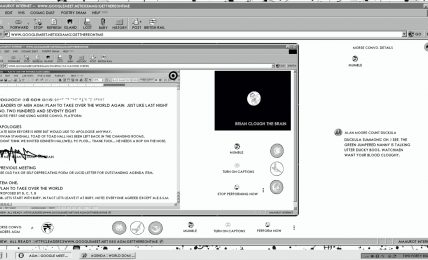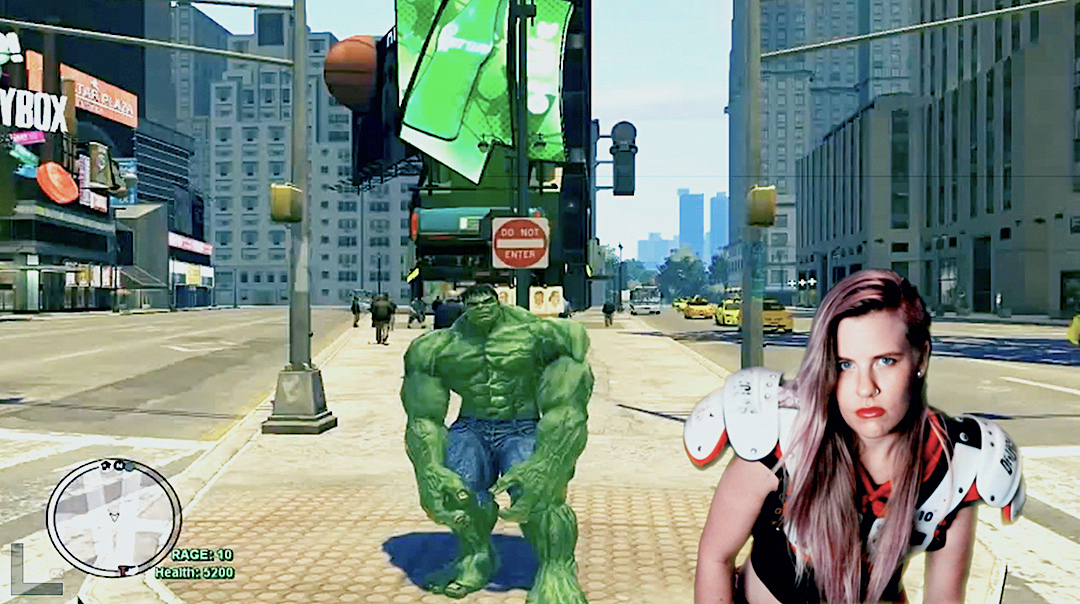Today’s cities are becoming increasingly dense as people choose to live more urban lives, which affects sustainability efforts put in place to protect the environment. Through the use of digital publishing platforms, students in Professor Scott’s class research innovative ways that a smart city can be implemented. How is it sustainable? How does it benefit residents? What primary goals drive the smart city? Six groups took on the challenge of creating smart cities. Take a glimpse into the future…
Smart cites of the future
[site no longer live]
Early thoughts: Our group believes in a sustainable community to have reusable energy. We want to preserve and save our energy with every day things such as heat, water, transportation, housing, technology, waste, and others. And we want to make sure our community is well rounded, and not focus on only one area of our community. There have been so many new things that I have learned about. All the different technologies to reuse and save energy have been flourishing and there are many countries that are putting to use of the technologies. We are very excited to put together our wonderful sustainable community.[site no longer live]
Process Blog: [site no longer live]
Final Project:
Megapolis
Early thoughts: Megapolis is a smart, sustainable, inspirational, model city created with a vested interest in agricultural gains. While increasing more intelligent transportation and housing methods, Megapolis focuses on employing renewable energy to better serve its citizens and pave the way for the cleanest possible future.
Process blog: http://digitalcommunitiesnclc375.tumblr.com
Final project:
Informatropolis:
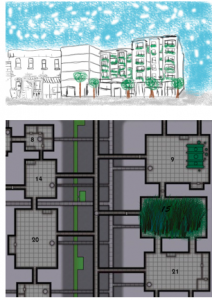 Early thoughts: The goal of our project is to analyze our world through the story it tells about itself over social media platforms such as: Twitter, Instagram, and YouTube. From this story we will construct a cultural identity and map of our current digital city (we’re not sure about the name yet, but we want it to reflect the ideas of a single city as the product of global consensus) and postulate how our society’s infrastructure and ideas will evolve from that perspective. To have an endpoint is certainly interesting, but the body of ideas that drive evolution and the global paradigm shift that will absolutely need to occur to promote a new sustainable world. Our process will involve the analysis of various social media and the construction of our city out of viral ideas and concepts. We will try to imagine ways in which these ideas will change the world, and come up with ideas as to how we can make use of these new communications to create the sustainable world (and culture) needed to deal with issues like over population, global warming and resource scarcity.
Early thoughts: The goal of our project is to analyze our world through the story it tells about itself over social media platforms such as: Twitter, Instagram, and YouTube. From this story we will construct a cultural identity and map of our current digital city (we’re not sure about the name yet, but we want it to reflect the ideas of a single city as the product of global consensus) and postulate how our society’s infrastructure and ideas will evolve from that perspective. To have an endpoint is certainly interesting, but the body of ideas that drive evolution and the global paradigm shift that will absolutely need to occur to promote a new sustainable world. Our process will involve the analysis of various social media and the construction of our city out of viral ideas and concepts. We will try to imagine ways in which these ideas will change the world, and come up with ideas as to how we can make use of these new communications to create the sustainable world (and culture) needed to deal with issues like over population, global warming and resource scarcity.
Process blog: http://acatgroup3.tumblr.com/
Final Project: http://mycitizenprofile.wordpress.com/
[site no longer live]:
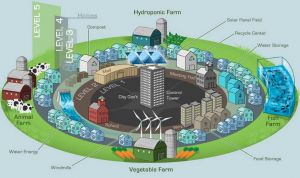 Early thoughts: Greenhouse is all about energy RENEWABILITY and food CONSERVATION. Our city is a modern green concept with all glass structures to eliminate wasted energy and the extinction of all fossil fuels to keep it green. We strive to have a strong educational system to ensure our sustainable community will live on past one generation. Greenhouse is going sustainable for the greater good!
Early thoughts: Greenhouse is all about energy RENEWABILITY and food CONSERVATION. Our city is a modern green concept with all glass structures to eliminate wasted energy and the extinction of all fossil fuels to keep it green. We strive to have a strong educational system to ensure our sustainable community will live on past one generation. Greenhouse is going sustainable for the greater good!
Process blog: [site no longer live]
Final project: [site no longer live]
Adobe:
Early thoughts: Adobe focuses on education, efficiency, and equality. A city must be shaped for all of the people, not some of them.
Process blog: http://nclcgroup4.tumblr.com
Final project:
A Look Inside Adobe (Digital City) from Tim Grant on Vimeo.
The EcoLoam Project:
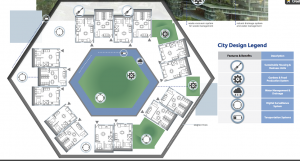 Early thoughts: The EcoLoam Project uses digital technologies to protect and maintain the natural environment. The EcoLoam Project is an ecosystem that thrives on the efforts of its citizens and the environment working together to regenerate and sustain the cycle.
Early thoughts: The EcoLoam Project uses digital technologies to protect and maintain the natural environment. The EcoLoam Project is an ecosystem that thrives on the efforts of its citizens and the environment working together to regenerate and sustain the cycle.
Process blog: http://ecoloam.tumblr.com/
Final project: http://amlandalexis.wix.com/theecoloamproject [site no longer exists]
Course Stats
Professor: Kristin Scott | Assistant Professor of Integrative Studies
Institution: New Century College @ George Mason University
Course: Digital Communities – a New Century College Learning Community
Project: Imagining a sustainable (or “smart”) city
Participants: Five groups
Some readings/viewings:
- Thomas More, “Utopia,” Book II, 1516
- Loretta Lees, “The Emancipatory City’: Urban (Re)Visions” from The Emancipatory City? Paradoxes and Possibilities, 2004.
- Marshall McLuhan and Quentin Fiore, The Medium is the Massage, 1967.
- David Lyon, “Surveillance in the City,” from The Cybercities Reader.
- Excerpts from Chapter 1: “Urbane-ing the City: Examining and Refing the Assumptions Behind Urban Informatics,” from The Practice and Promise of the Real-Time City.
- Dark City
- The Matrix
- Brave New World
In their own words:
We started out the first three weeks of class talking about cultural imaginaries of cities. We began by looking at an excerpt from Thomas More’s Utopia, and his description of a perfect utopian society. We also explored the notion of the “emancipatory city”—the ways in which cities often have been historically perceived as places of progress, freedom, democracy/thriving public sphere, and diversity and heterogeneity. Conversely, we also explored how the city often has been imagined as a perilous place—alienating, isolating, fragmented, and dangerous. We had some really good discussions about how cities historically have been imagined and described in cultural narratives as both utopian and dystopian places, and I emphasized how these two concepts are co-constitutive. We also put these ideas into context by briefly exploring how cities have been in great part defined and imagined in relation to nature (and again, how these ideas of nature vs. city are similarly co-constitutive).
The following week, we then explored some (similar) cultural narratives of digital technologies (the promises and perils of digital technologies). We engaged in discussions of how technologies in general, and digital technologies more specifically, have also been imagined and articulated in similar ways as the city (both with utopian and dystopian elements). And then we also read and discussed McLuhan’s The Medium is the Message, focusing on concepts such as the “globe village,” technologies as an extension of self, the medium as the message, technological determinism, and perceptions of technologies as a panacea to social problems. I also set the stage for future discussions of media ecology, so they could start thinking about digital technologies as an “environment.”
[Recently,] we began to explore the intersections between the cultural imaginaries of cities and digital technologies, as well as starting to think about what “digital city” even means. I gave them a really brief overview of how both scholars and public intellectuals have theorized early iterations of the digital city since early 1990s—thinking about, for instance, the concept of the “information society,” early media theories about cyberspace vs. real space, utopian-like articulations of the internet and cyberspace, how cyberspace was often described in non-material (ethereal) ways, and so forth. We then followed this trajectory up the present moment, discussing the backlash against these earlier utopian-like theories—social networks, social media, and a very brief overview of the political economy of media and digital technologies. – Professor Kristin Scott

Creating a digital city has been a positive, yet challenging experience. I have enjoyed researching new technologies and creating our own; however, my group quickly learned that we must focus only on a few items in our city in order to finish with in the time requirements. – Amanda Hutchings

So far the most challenging part of this experience is coming up with a unique way to approach the construction of our digital city. The project allows for a lot of possibilities, but we’re dealing with common problems with a few common solution paths that cities seem to be following. – Amber Boice

Thus far, I have found our Digital Sustainable City Project to be very exciting. I was lucky to be placed in a group where we have a lot of diverse ideas, but our main goals for the project have aligned with each other quite well. Our group has been making significant progress to achieve research goals and brainstorm design ideas. – Alex Amland

When asked to create a digital sustainable city, Wendell Berry’s indictment of the industrial food system immediately comes to mind. He says: ‘We are in exile from our biological reality.’ That’s where I want to go with this project. I want every step the citizen takes to bring them closer to their environment and impress upon them their role in the ecosystem. – Sara Louise Evers

To me, one of the best parts about this creative process is being exposed to other individuals’ mentalities and converging all that which we feel is important to this sustainable city. I love what each group member has to offer and that we all think differently about what to add to the successful creation of Megapolis. We all bring outside experience to this project, whether it’s having used Prezis or Wix or Photoshop, or even having made sustainable efforts in our local community. Our strengths are in numbers, and we will see that Megapolis thrives as the model city which it is intended to be. – Erin French

The great thing about this project is that I get insight to the future. I had no idea so many people have studied and researched this type of information. It’s sometimes tricky to find, but worth the effort. – Tim Grant

